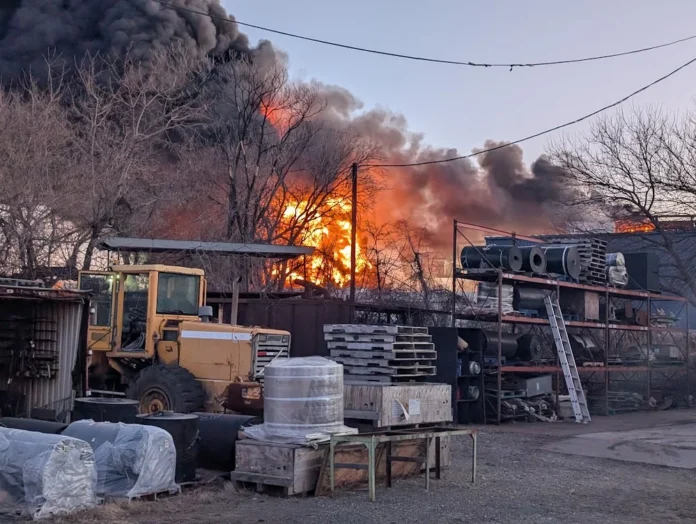In a major development for Camden’s Waterfront South neighborhood, EMR, a U.K.-based metal recycling company, has agreed to pay $6.7 million in compensation after a devastating fire at its facility in February 2023. The fire, which temporarily displaced over 100 families, was the latest in a troubling series of incidents at the recycling plant, which has a long history of environmental and safety violations.
This new agreement, negotiated by Camden Mayor Victor G. Carstarphen, comes as the city seeks to address long-standing community concerns about the company’s operations. While the deal offers significant financial support, it also signals the need for stronger measures to ensure the safety and well-being of the Waterfront South community, which has endured multiple fires over the past decade.
Fire in February: A Wake-Up Call for Camden
The fire erupted at EMR’s facility at 1400 So. Front Street on February 21, 2023, and was reportedly caused by a lithium-ion battery, which was illegally concealed with scrap metal. These batteries, which cannot be recycled at EMR’s facility, ignited a blaze that forced 100 families to evacuate their homes and disrupted the entire Waterfront South neighborhood.
According to a report from the Philadelphia Inquirer, the fire is believed to have started due to improper disposal of a lithium-ion battery, which is not accepted at the facility. The battery had been hidden within a load of scrap metal, circumventing the recycling company’s internal procedures. This kind of reckless handling of hazardous materials, combined with the company’s track record of environmental violations, raised alarms about the long-term impact of EMR’s operations on the Camden community.
In the aftermath of the fire, residents and community leaders quickly rallied, demanding accountability from EMR and the city. They called for tangible action—not just compensation—to prevent future incidents and protect their homes, families, and livelihoods.
$6.7 Million Deal: Compensation and Community Investment
The $6.7 million deal negotiated by Mayor Carstarphen will see EMR pay $4.5 million by the end of 2023, with an additional $450,000 paid annually over the next five years. The funds will be directed toward critical needs within the Waterfront South neighborhood, including improvements to local schools, housing, medical facilities, and other community resources.
EMR has committed to working with local stakeholders to allocate these funds for several specific initiatives:
- Neighborhood Improvements: The money will go toward funding neighborhood cleanups and revitalization efforts to address the damage caused by the fire and its aftermath.
- Healthcare and Services: A portion of the funds will be dedicated to creating space for medical care and other essential services for the residents who were affected by the fire.
- Community Engagement: A new text notification system will be developed to alert residents about any future incidents at the facility. Additionally, annual open house events will be held, allowing residents to engage directly with city leaders and EMR representatives about safety measures and community concerns.
“The agreement that my administration negotiated on behalf of the residents of Waterfront South and the other adjacent neighborhoods provides meaningful compensation to the city’s Waterfront South community, helps to safeguard against the threat of fire, and outlines meaningful changes at its location,” said Mayor Carstarphen in a statement.
For residents like Carlos Morales, the executive director of Heart of Camden, the deal is a step in the right direction, but it also highlights the broader issue of accountability and responsibility. “The February fire was a wake-up call,” Morales said. “It forced more than 100 families out of their homes and put our entire neighborhood at risk. Since day one, we’ve demanded accountability and real investment—not just words or promises. This agreement is a direct result of pressure from the community and from us.”
EMR’s Commitment to Change: What Happens Next?
While the $6.7 million payout is a significant financial commitment, the community is looking for more than just compensation. The deal also includes a number of operational changes at the facility that EMR will need to implement to ensure that this type of incident does not happen again.
Some of the key measures being put in place include:
- Reducing the Facility’s Footprint: EMR plans to reduce its operations in Camden by 9 acres, helping to limit the amount of material stored on-site and potentially reducing fire risks.
- Enhanced Inspections: The company has committed to increasing the frequency and rigor of material inspections to prevent hazardous items—like lithium-ion batteries—from being brought into the facility.
- Stricter Storage Guidelines: EMR has also agreed to limit the amount of material stored on-site at any given time, further reducing the risk of a large-scale fire.
Joseph Balzano, the CEO of EMR USA, acknowledged the company’s responsibility, stating, “This agreement strengthens our commitment to the Waterfront South neighborhood and underscores my dedication to keeping our site safe. This is a long-term agreement in partnership with the city to deliver positive change to residents of Camden who were adversely impacted by the fire on Feb. 21.”
However, for many residents and local activists, this deal is just the beginning. Waterfront South has faced repeated fires and environmental violations from EMR over the years, including incidents where the company was cited for emitting smoke and air pollutants that posed a potential public health threat. Given this history, many in the community remain cautious, questioning whether these new commitments will be fully upheld and whether the company is truly changing its ways.
The Road Ahead: Community Empowerment and Accountability
While the financial agreement and the operational changes are a step in the right direction, Waterfront South residents are still looking for further reassurances. They want to ensure that EMR is not just paying off the city but is committed to the long-term safety of the community.
One key point of focus is ensuring that the neighborhoods surrounding the facility are not just financially compensated but are also actively involved in the process of change. The community’s ongoing engagement through open houses, stakeholder meetings, and transparent reporting will be crucial in holding EMR accountable for future operations.
Ultimately, for Waterfront South, the goal is clear: safety and accountability. As Mayor Carstarphen said, “This agreement will help safeguard against future fires and ensure that the Waterfront South neighborhood gets the attention and investment it deserves.”
With a series of legislative changes on the horizon and a more engaged community demanding action, Camden’s Waterfront South neighborhood is hoping that this agreement marks a turning point—a commitment to lasting change that will protect families and future generations from the dangers posed by hazardous industrial practices. Only time will tell if these promises are fully realized.
A Community Under Siege: The History of Fires at EMR
Waterfront South has been a community on edge for nearly a decade due to the repeated fires that have ravaged the EMR facility. For residents, it’s a troubling pattern—one that has caused physical damage to property, emotional distress, and a growing sense of frustration with the lack of sufficient action from the recycling plant and the city.
The February fire, which forced the temporary closure of the facility, was one of the most destructive and intense in recent years, prompting the city to act. The Camden Fire Marshal’s report paints a harrowing picture of the chaotic scene, detailing how EMR workers disregarded firefighters’ instructions and allowed flaming debris to spread throughout the area, exacerbating the crisis.
This particular fire was the latest in a series of blazes that have put the community’s safety at risk, including a particularly devastating fire in 2019 that led to severe property damage. In total, the neighborhood has witnessed six fires in just nine years, with the EMR facility at the epicenter of each one.
For those living in Waterfront South, the fires are more than just an inconvenience—they are a constant source of anxiety. “You don’t feel safe in your own home,” said one local resident. “We’ve been asking for better oversight for years, and nothing’s really changed.”
The $6.7M Deal: A Step Toward Financial Compensation, But What About Long-Term Solutions?
The impending $6.7 million deal between Camden City and EMR will see the company invest in improvements to the local area, including much-needed infrastructure updates and community programs aimed at alleviating some of the damage caused by their operations. The agreement also includes provisions for strengthening the facility’s safety measures, such as improved fire prevention systems and employee training to ensure that the disastrous response seen in the February fire does not repeat itself.
However, while the deal promises short-term relief, the community remains skeptical. Many residents are asking the hard question: Will this be enough to stop the cycle of fires, or is it just another temporary fix?
The ongoing strain has prompted the City Council to seek additional measures that would ensure accountability. Legislative changes have been introduced to tighten the rules surrounding metal recycling plants like EMR, and could result in harsher penalties for companies that violate safety standards or fail to comply with fire safety regulations.
Legislative Changes: Sharpening the Teeth of Enforcement

While the $6.7 million agreement provides immediate financial support for the community, it is the recent legislative changes that have garnered the most attention. New regulations are now being proposed that would grant city officials and the New Jersey Department of Environmental Protection (NJDEP) greater authority to enforce safety measures at industrial sites like EMR.
These legislative changes aim to:
- Increase fines and penalties for companies that fail to adhere to safety regulations.
- Mandate regular safety inspections and fire safety audits to prevent future incidents.
- Ensure that companies invest in fire-resistant materials and equipment to minimize the risk of accidents.
- Create a transparent reporting system so that residents are made aware of fire hazards or violations on site.
The hope is that by increasing the penalties for non-compliance, the city will be able to enforce stricter standards and discourage the kind of negligence that has repeatedly put the community at risk.
“It’s about more than just money,” said Camden City Councilman Vic Carstarphen. “We want to ensure that EMR is held accountable and that they invest in the community, not just pay lip service to it. These new laws will give us the tools to take stronger action.”
Residents Demand Accountability: A Call for Real Change
While the financial compensation and regulatory changes are certainly a step forward, Waterfront South residents are calling for more. For many, the issue isn’t just about compensation, but about ensuring safety and accountability for the long term. The frustration is palpable, with many residents expressing that they have been left in the dark too often.
Maria Garcia, a lifelong resident of Waterfront South, spoke about the challenges of living in the shadow of EMR’s facility: “We’ve seen our homes damaged, our health affected, and our lives interrupted. This has gone on long enough. We don’t just want a check—we want a guarantee that we’re safe.”
Many are questioning why EMR has been allowed to operate without stronger consequences, especially considering the pattern of incidents at the facility. After all, this latest fire was not an isolated event, but part of a larger issue that dates back years.
“The company needs to prove they’re committed to doing better,” said John Martinez, another local resident. “We’ve been promised action before, but it’s never enough. This time, they need to show us that they’re serious.”
What Comes Next for Camden’s Waterfront South?
While the $6.7 million deal marks a significant development, it’s clear that Waterfront South’s residents are looking for more. The combination of increased funding, enhanced safety measures, and stricter legislative oversight could pave the way for a safer future for the neighborhood. However, only time will tell whether these efforts are enough to break the cycle of fires that has plagued the community for nearly a decade.
The city, residents, and EMR will now need to work together to ensure that the promises made in the wake of February’s fire are followed through, and that the Waterfront South neighborhood is no longer left to bear the brunt of an ongoing environmental and safety crisis.
Conclusion: Accountability and Action Are Key
As Camden moves forward with this deal, accountability and long-term safety will remain at the forefront of the conversation. The community’s demand for reassurance is not just about financial compensation, but about preventing future disasters and ensuring that EMR—and other businesses like it—take responsibility for their impact on the neighborhood.
For now, the city has taken an important step, but the journey is far from over. The people of Waterfront South deserve more than just a quick fix—they deserve a sustainable solution that puts their safety, well-being, and peace of mind first.











